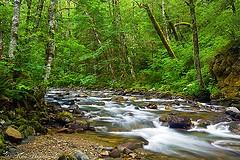
Roy Brooke
Society understands the value provided by green space, streams, forests and lakes. Far too often, however, these ‘valuations’ can’t be converted into something that business owners, city planners and politicians can easily use for decision-making. As a result, the valuation of natural capital, despite its massive potential to stop or reverse the decline of our dwindling ecosystems, remains an academic or communications exercise.
At first glance, the town of Gibsons on Canada’s West Coast seems an unlikely challenger to this state of affairs. But in this outwardly sleepy town, a change is brewing that is moving the community from ‘valuing’ natural capital to actually doing something about it. The implications are huge.
In fact, Gibsons is now ahead of any other town or city on the continent in its efforts to weave natural capital into the DNA of urban decision-making.
Gibsons is doing three things:
- First, the town is translating the value of its natural assets (forests, streams, shoreline, etc.) into tangible ‘municipal service’ terms such as rainwater management, flood control and water purification.
- Second, town government is calculating the risks and costs if these features get degraded. For example, the town realized one of its parks was not just a nice spot for joggers, but also the chief reason that it required less expensive storm-water systems. If the park were to get degraded, the town would be on the hook for huge new sewer expenses.
- Third, and most important, the town has adopted North America’s first asset management policy. This policy recognizes natural assets as an asset class, and enables the town to use traditional infrastructure and financial management systems to manage their natural assets.
Practically speaking, natural assets that were once invisible in the town’s ledgers are now front and center, with operations, maintenance and financial plans to ensure their integrity. And because forests and beaches cost nothing to build and less than storm sewers and seawalls to maintain, cost savings are the key result emerging from the protection of nature and the services it provides.
Other municipalities are starting to explore the eco-asset approach.
The city of North Vancouver, for example, recently adopted an updated official community plan which highlights how tracking and recording natural assets, then applying physical asset management approaches to them, leads to better planning decisions.
The city of St. Peters, Missouri, meanwhile, has developed an asset management program and conducted a condition assessment of its natural assets. This, in turn, has led to:
- The identification of priority projects to manage storm-water and water quality issues,
- The development of a funding mechanism for related capital projects, and
- An additional contribution to a growing number of good practices that managers of municipal assets can draw from.
Although the approach is in its infancy, interest in it is growing. Chances are, the practices will be rapidly shared as more cities discover triple-bottom line environmental, economic and social benefits.
Image credit: Ken Hornbrook, Flickr
Roy Brooke has held leadership positions in Canada, Europe and Africa, in fields including urban and organizational sustainability, national politics, international development, and humanitarian affairs. He is now Principal of Brooke and Associates, a consulting firm that helps organizations and communities maximize social and environmental outcomes. roy@brookeandassociates.com.
TriplePundit has published articles from over 1000 contributors. If you'd like to be a guest author, please get in touch!














